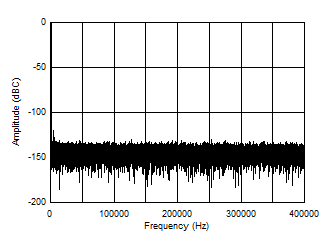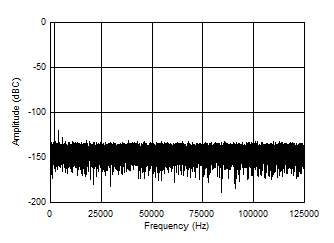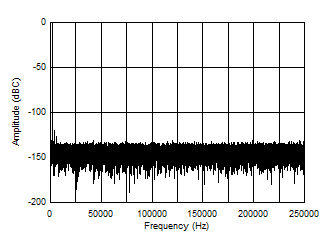ZHCSKT9C January 2020 – March 2021 THP210
PRODUCTION DATA
- 1 特性
- 2 应用
- 3 说明
- 4 Revision History
- 5 Pin Configuration and Functions
- 6 Specifications
- 7 Parameter Measurement Information
- 8 Detailed Description
-
9 Application and Implementation
- 9.1 Application Information
- 9.2 Typical Applications
- 10Power Supply Recommendations
- 11Layout
- 12Device and Documentation Support
- 13Mechanical, Packaging, and Orderable Information
9.2.2.1.1 Measurement Results
The THP210 and the filter combination listed in Section 9.2.2.1 allow for the best trade-off between harmonic distortion and maintaining stability of the FDA. Table 9-1 and Figure 9-13 through Figure 9-15 showcase the device performance.
Table 9-1 THP210 + ADS891x: FFT Data Summary
| ADC VERSION | ADC SPECIFICATION | SAMPLING RATE | SNR | THD(1) | SINAD |
|---|---|---|---|---|---|
| ADS8910B | 1-MSPS max, 18 bit | 800 kSPS | 100.37 dB | –118.4 dB | 100.31 dB |
| ADS8912B | 500 kSPS, 18 bit | 500 kSPS | 100.4 dB | –118.44 dB | 100.33 dB |
| ADS8914B | 250 kSPS, 18 bit | 250 kSPS | 100.37 dB | –118.72 dB | 100.33 dB |
(1) THD can further be improved by
providing a bipolar power supply for more headroom for the negative voltage
swing. In the given circuit, a negative supply of VS– = 0.23 V
improved the THD to –120.5 dB.

| fIN = 2 kHz, 100.37 dB SNR, –118.4 dB THD |
THP210 + ADS8910B, 800 kSPS, 18-Bit

| fIN = 2 kHz, 100.37 dB SNR, –118.72 dB THD |
THP210 + ADS8914B, 250 kSPS, 18-Bit

| fIN = 2 kHz, 100.4 dB SNR, –118.44 dB THD |
THP210 + ADS8912B, 500 kSPS, 18-Bit